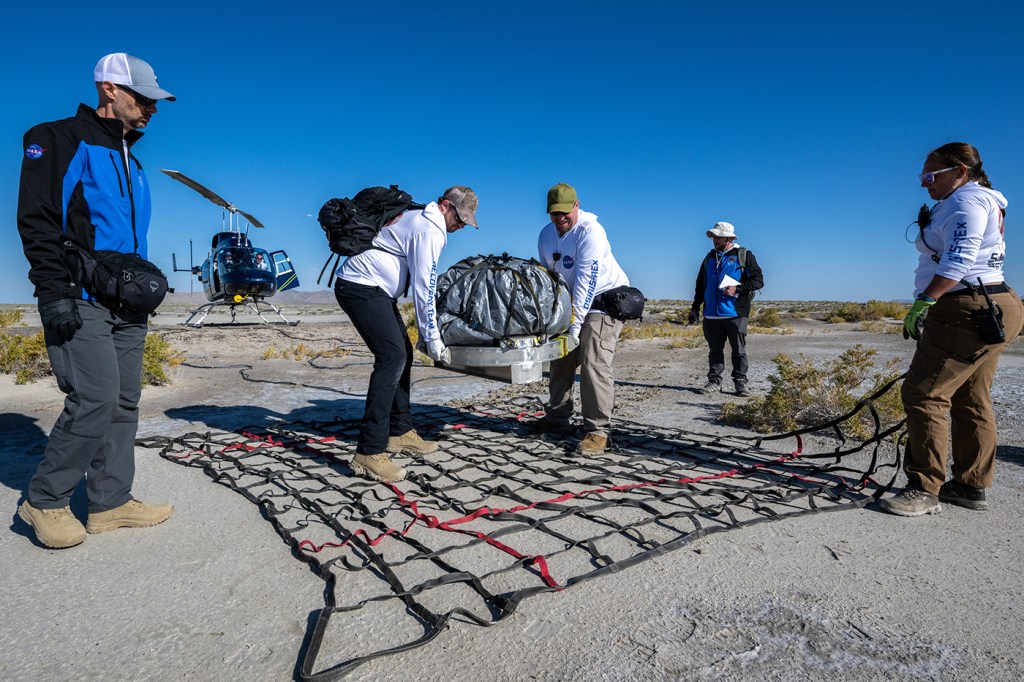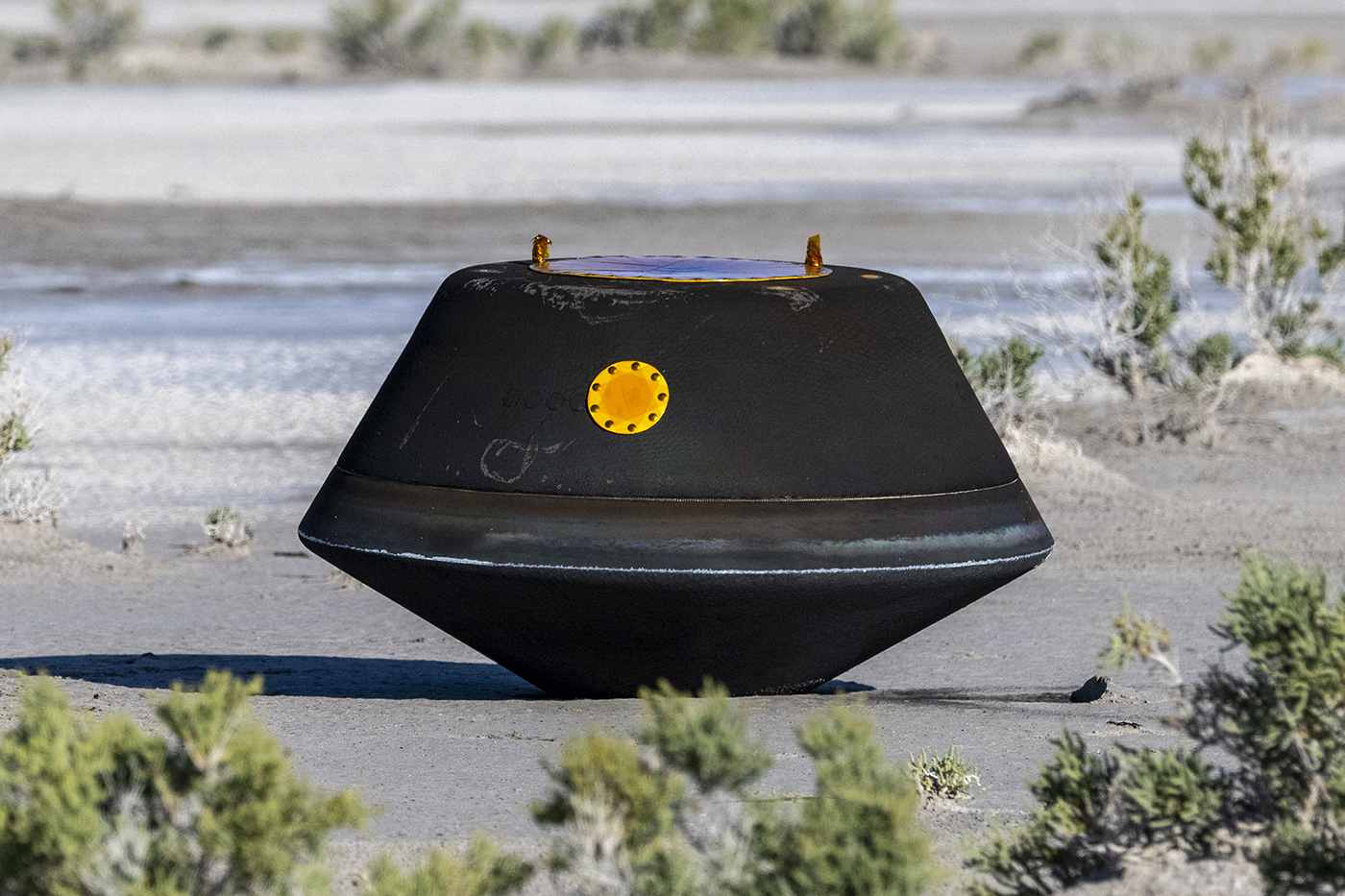Rock and dust from asteroid Bennu offers unprecedented opportunity to study origins of the solar system, cosmologist says

The recovery of 8.8 ounces of rock and dust from the asteroid Bennu on Sunday is a scientific game changer, says Northeastern physics professor and cosmologist Jacqueline McCleary.
She says researchers now have evidence from the formation of the solar system literally at their fingertips.
“The thing that’s most exciting to me is scientists getting to touch the material,” says McCleary. She says astrophysicists typically use images from powerful telescopes to study everything from the formation of the solar system to galaxy clusters and the nature of dark matter.
“As an astronomer, I ask, ‘What can these pixels tell me? What can these pictures tell me?’ so I can extrapolate backwards.”
A first for NASA
“The thought of actual asteroid dust here on Earth, not a pixel, something physical and real, is so exciting. It’s like nothing you can get on Earth, literally,” McCleary says.
“It will help our understanding of what the solar nebula looked like at the time the Earth formed” 4.6 billion years ago, she says.

The recovery of the sample from Bennu after a NASA space capsule landed at the U.S. Army’s Dugway Proving Ground in Utah marked the first time the space agency has taken a sample of an asteroid.
The $1 billion mission got underway in September 2016 with the launch of NASA’s OSIRIS-REx spacecraft, which traveled about 200 million miles to arrive at Bennu in 2018 and collect a sample in 2020.
A pile of rubble
Bennu is less like a rock and more like a “barely self-gravitating pile of rubble” thanks to its high water content, McCleary says. “It is quite porous.”
The asteroid’s unusual composition made collecting the sample hazardous, according to Space.com, which said OSIRIS-REx “only escaped from being swallowed up by the squishy sphere thanks to its powerful thrusters.”
NASA scientists and engineers breathed a sigh of relief Sunday when the space capsule carrying the samples made a successful landing in the Utah desert with the help of two parachutes after being released by the OSIRIS-REx probe 63,000 miles above the Earth.
NASA Administrator Bill Nelson called it a “picture perfect mission” that “will deepen our understanding of the origin of our solar system and its formation.”
Special rocks are ‘pure’ relics
“The reason why these rocks are so special is that asteroids, even ones in near Earth orbit, are almost pristine relics of the material in the early solar system,” McCleary says.
Rocky material on Earth, on the other hand, has been so “reprocessed through erosion from wind and rain, volcanic activity and even meteor impact,” that it can be hard to distinguish the earliest materials from weathered materials, she says.
“Even when meteors land on Earth, they’ve gone through the atmosphere, they’ve burned up, they’ve hit the ground,” says McCleary, an observational cosmologist who uses galaxy clusters as a laboratory in which to explore the nature of dark matter and its interaction with galaxies.
“It’s very hard to separate what is Earth dirt from what formed in the solar system,” she says. “So a sample return mission gives us a clue into what exactly the composition of the early solar system was like before any kind of erosion or volcanic activity.”

Nitrogen ‘purge’ then big instruments
NASA scientists say one of the first things they did with the sample from Bennu was to give it a nitrogen “purge” by injecting a continuous flow of the gas into the sample container inside the capsule.
“Nitrogen is an inert gas that doesn’t chemically affect anything it comes into contact with. It sort of sits there like a blanket,” McCleary says.
She says subjecting the samples to a nitrogen “purge” ensures “zero contamination from Earth materials.”
The samples were scheduled to be transported in the unopened canister to NASA’s Johnson Space Center in Houston on Sept. 25 for processing, according to NASA.
The reason why it was important to bring the asteroid samples back to Earth is because the instruments scientists will use to study their composition are in some cases much bigger than the space probe that picked them up, McCleary says.
While the sample may fit in the palm of the hand, spectrometers used to analyze it “can be room sized,” she says.
“One of the advantages of bringing this material back to Earth is it can be analyzed with instruments that are far, far more sensitive than you would put onboard a spacecraft.”
Preventing a hit
NASA officials said studying the samples from Bennu will not only lead to increased understanding of planet formation, the origin of organics and water that led to life on Earth, they could also provide information about “potentially hazardous asteroids.”
“Bennu is technically in an Earth-crossing orbit, meaning it doesn’t just hang out in an asteroid belt. Its orbit does take it past the Earth. So it was already on a list of potentially hazardous near-Earth objects,” McCleary says.
Bennu could hit the Earth in 2182, according to Space.com.
“The more that we learn about asteroids like Bennu, the more we understand the composition of those asteroids, the better we can prepare planetary defenses — essentially understanding what kind of ballistics you might need to redirect an incoming asteroid,” McCleary says.
The samples will be studied for decades to come, says McCleary, who worked at NASA’s Jet Propulsion Laboratory in California at the time OSIRIS-REx launched in Florida seven years ago.
Fifty years after the Apollo missions, scientists are still studying lunar material collected at the time, she says.
“Think about how much scientific instrumentation could advance in the next 50 years. What else will we be able to learn from this precious material from Bennu?” McCleary asks.
Cynthia McCormick Hibbert is a Northeastern Global News reporter. Email her at c.hibbert@northeastern.edu or contact her on Twitter @HibbertCynthia.





